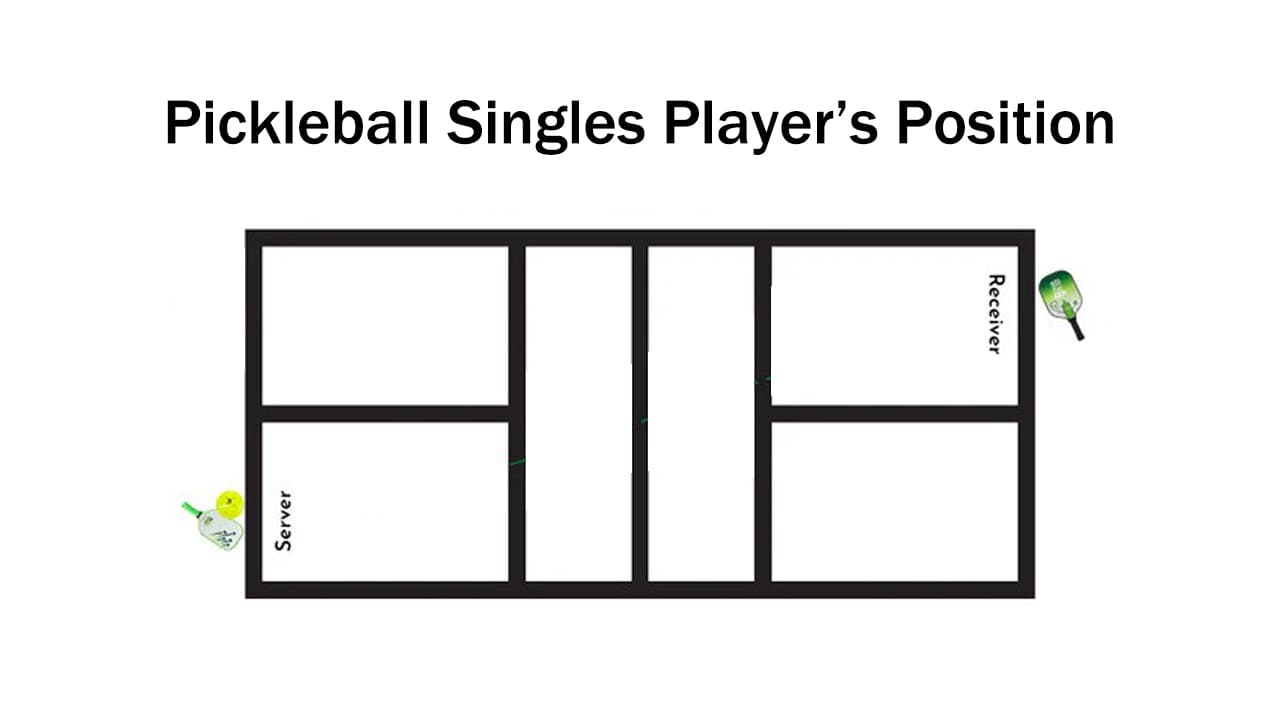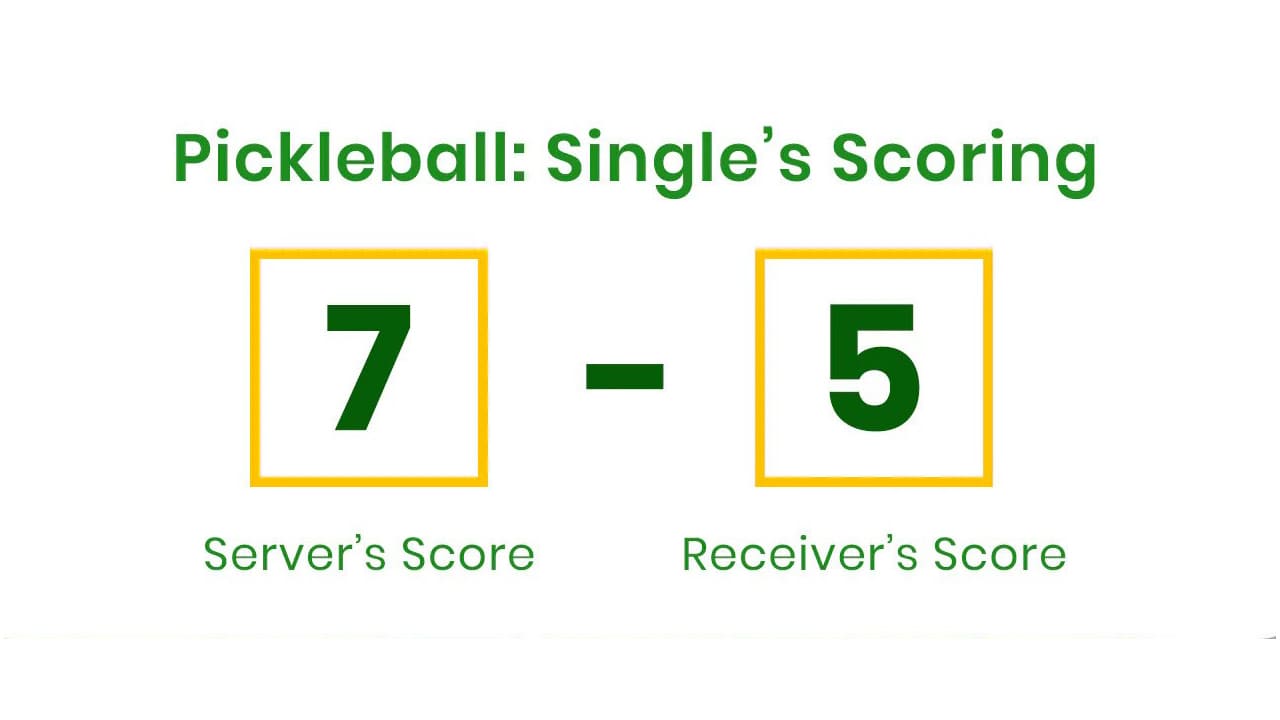Here is your one-stop rulebook with pickleball singles rules, violations, faults, common mistakes, and basic strategies.
Pickleball Singles Rules
Many of us are aware of the doubles pickleball, while it is also important to know about the singles game, which is much more competitive and aggressive. Pickleball singles is a physically and mentally demanding game in terms of strategy and agility. If you are wondering how to play this game, here is everything you want to know about pickleball singles rules, so dive right in.
How To Play Singles Pickleball?
Playing singles pickleball is easier than the doubles game. These two games have different scoring rules, serving strategies, and players positioning. Here is how you are required to quick-start and follow a singles pickleball match.
- Like doubles pickleball, singles is played generally to 11 points and anyone with 2 more points wins the match. It is just like any other paddle sport where the aim is to get the ball over the net without bouncing it twice.
- The ball is served diagonally across the net to the opponent’s side of the court and underhand. Then, the ball will hit back and forth across the net until one side fails to return the ball.
- The server gets a score when he/ she wins the rally. The server is supposed to continue serving until they lose a point. Here, the opponent has the chance to serve.
Court Positioning
Singles pickleball is generally played on a standard court, but there are no separate lines for singles, as is the case with tennis courts. Here, the size of the court is supposed to be 20×44 ft., with 15 ft. from the baseline to the non-volley zone or kitchen from each side. The non-volley zone is generally 7 ft. from the net.
The pickleball court size is generally one-third or one-fourth of the tennis court, which means there will still be a lot of areas to cover. Moreover, the net is always 34 inches higher from the center and 36 inches higher at the posts.
Players Positioning
Now that we have understood the court dimensions, let’s get into the player’s positioning for singles pickleball. Here, the first serve will always start from the even or the right side of the court. If the server wins the point, he keeps serving and switches to the other side of the court. The server will always serve diagonally or crosscourt.
If the server in singles is in the wrong position, a fault occurs and the server will lose a point. A fault can be considered upon contact of the serve up until the next serve occurs. If a fault occurs prior to the next serve, the server loses a rally and he will get no points.
Moreover, if the fault occurs after the serve, the server will get a rally and it is considered a score. However, when a fault occurs on the last point of the match, the result will be the same unless a fault is committed prior to returning the scoresheet to the operation personnel.
Server Rules
Serving is mostly the same in singles as in doubles, and the first serve is taken from the right side of the court. Here, traditional methods like tossing the coin are used to determine who gets the first serve.
Proceeding further, if the server wins a score, they get another serve. However, they will move to the left side of the court this time. Until they commit a fault or lose the score, they will keep on serving from alternate sides.
Once they commit a fault or lose a score, the opponent side gets a serve, and it is usually known as side-out. If this is the first serve of the opponent, they will start it from the right side of the court.
As the game progresses, you will have to remember the scores, as it will help you know which side of the court to serve from. For instance, an even number means you will serve from the right side and vice versa.
Scoring
When it comes to scoring in pickleball, singles have it easier, and anyone who has already played doubles will figure it out in minutes. In doubles, there is a third number that determines which teammate is serving, which is not used in singles, simplifying the scores.
In singles pickleball, the score is the number of points each player has got, such as 2-1. This score indicates that the person with two points has the serving right, as the player who is serving has their scores written first.
Here, the most important rule to understand is the “Win by 2 Rule”, which usually indicates that each pickleball singles game, played for up to 11 points will be won by the side with two more points than the opponent side.
In singles, it is not uncommon for a game to draw, since a win requires at least having two points more than the other side. The only way to resolve a tie in a single game is to continue playing until one player has two more points than the opponent.
Volley/Double Bounce
In singles pickleball, the volleying rules are mostly similar to doubles, and here the double bounce rule applies. According to this rule, the ball has to bounce one time on each side of the court before the player hits the ball out of the air. A player cannot step into the NVZ or the NVZ line when hitting the ball out of the air.
Other Rules For Singles Pickleball
Here are some others for singles pickleball that are similar to the doubles pickleball.
- The server must serve underhand, either as a drop serve or a volley serve.
- The serve should also go diagonally across the net and land beyond the kitchen on the opponent’s side.
- Only one serve attempt goes to the server.
- All lines are “in” on the court except on the serve. If the ball touches the kitchen line, it is considered a violation.
Basic Singles Pickleball Strategies for Beginners
The singles and doubles pickleball strategies are poles apart, as the rules are different for each. You are alone in the game, and your scores are mostly dependent on you. Here are some key tactics to achieve superiority in a singles pickleball match.
- Big, Deep Serve: In singles pickleball, a big, deep serve is important. For this, you need to have a serve for a competitive edge against the opponent from the first shot.
- Big, Deep Return of Serve: A big, deep return of the serve is also significant to cut off your opponent’s angles and get ahead of them. Returning the serve will help you move the ball into the non-volley zone line, so you can easily cut the angle in the third shot.
- Centerline Position When Serving: It is better to position yourself near the centerline while serving so that you can effectively cover the right and left sides of the court while returning the serve. If you serve too close from one side in singles, returning the serve will become extremely challenging.
- Percentage Pickleball: You need to expect and play the percentages. The pickleball net is generally higher at the post and lower at the center. You can take advantage of this knowledge to play high-percentage shots. However, you must understand that the opponent also has this information and he will most likely target high-percentage shots, and it is your chance to hit low-percentage shots to cut them off.
- Hitting Drop Shots/ Passing Shots: If the opponent side is on the non-volley line and you are standing at the baseline, you have several options to select your next shot. Here, you can hit a hard passing shot that crosses the net and dips directly into the non-volley zone or hit a lob with the lowest percentage.
- Move into the Non-Volley Zone Line: It is significant to cut off your opponent’s angles on the court during singles pickleball. The best way to do this is to make your way in the non-volley zone line. Meanwhile, make sure to follow the pickleball flight.
- Angles and Passing Shots: As singles pickleball mostly takes place on a one-yard court, it has mostly to do with finding the open court. So, when you are out there, use the angles and passing shots to get a competitive advantage.
- Strong Placement: Strong placement is key for both singles and doubles pickleball. However, it is slightly more important for singles, as you are alone in the court, and there is no partner to back you up.
Common Singles Mistakes In Pickleball
There are a few common mistakes players make when starting their game. Most players lose their points when they position their foot across the baseline, on the non-volley one, and other relevant violations. Here are some of them so you can be mindful of them from the start.
- Serving land in any part of the non-volley zone. It eventually ends up on its line, called the kitchen.
- Most newbies make the mistake of throwing the ball in the kitchen, which is not allowed (and is referred to as a non-volley zone). What you can do is throw the ball from the kitchen so that it touches the ground first.
- The serve failed to cross the net. Or, it is hit out of the set bounds.
- Newbies fail to volley the serve underhand. However, there are some specifications to this, but the most common case is not making contact with the ball below the waist when you are serving.
- The ball hit out of the air before it hit the ground once on each side after serving. This mistake is commonly known as the two-bounce rule.
- The foot faults occur when the player steps on or across the non-volley zone line, accidentally. However, it is common for players to hit the ball past the NV zone line while they are serving.
What Are The Common Differences Between Pickleball Singles And Doubles?
As mentioned above, the singles and doubles pickleball are different though they are played with a few similar general rules. In a singles game, you do not have to rely on the teammate, and you have to trust yourself to cover the entire court yourself. Hence, it is physically much more demanding, and you will need speed, agility, and strategies to place your shots.
Moreover, in singles games, the play is not centered near the net area, and it is better for the players to get closer to the opponent’s Non-Volley Zone line, so it is easy for one player to get trapped in the backcourt and restrict their movement. This way, the game will have much more open and longer shots.
The singles pickleball game includes many groundstrokes from the backcourt, as one player is there to cover the entire court by themselves. They will also hit more angles from the kitchen line in this game.
Another difference between these two games is that singles pickleball is less friendly and includes more competition. When you are playing recreationally, pickleball is a social game and you get to interact and collaborate with your partner. There is plenty of opportunity for the players to relieve stress, enjoy conversation, and laugh during the game.
Frequently Asked Question
Can Just Two People Play Pickleball?
Yes, like many other paddle sports, pickleball is for two people. It is generally known as singles pickleball, where both players cover each side of the court.
What Are Skinny Singles In Pickleball?
Skinny singles is a type of singles pickleball match in which you divide the court in half, making it easier to cover the court while you are still playing one vs. one.
Can I Serve Consecutively In Singles Pickleball?
Yes, if you serve and receive a rally, the next serve goes to you. However, this time, you will serve from the other side (generally left) of the court.
Final Thoughts
Finally, playing singles pickleball can be demanding but it comes naturally when you practice and adapt to a different court setting. I hope this guide has helped you understand the singles game.
Other Related Posts:
- Serving Rules In Pickleball
- Third Drop Shop In Pickleball
- Pickleball Dinking Strategies
- Pickleball Skill Rating
- Pickleball Terms

I, Jeena Noven, am a renowned pickleball expert and author with over 10 years of experience playing and coaching the sport. My passion and extensive knowledge of pickleball has made me a leading authority in the game, particularly in the field of footwear. I have written countless articles for https://pickleballcard.com/, a website dedicated to pickleball, sharing my insights and expertise on the best shoes for the sport. Through personal testing and reviewing countless different brands and styles, I have developed a deep understanding of the technical aspects of shoe design that make them suitable for the demands of pickleball. In my articles, I provide valuable information for both beginner and advanced players, covering everything from the basics of shoe fit and support, to advanced tips for maximizing performance on the court. As a dedicated pickleball player and expert in footwear, I am a valuable resource for players of all levels. My articles are not only informative but also engaging, making them a must-read for anyone looking to improve their pickleball game. I am constantly researching new products and trends in the industry and my readers can always count on me to provide the most up-to-date and accurate information on the best pickleball shoes available.


Leave a Reply